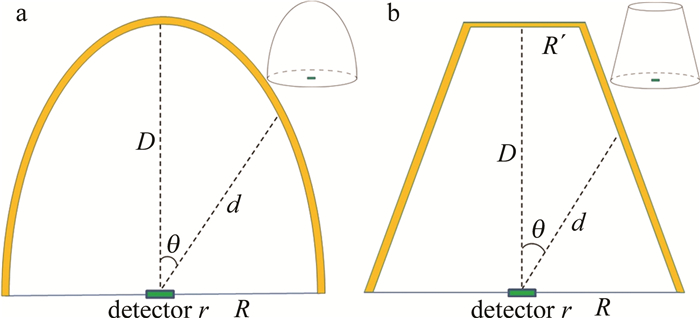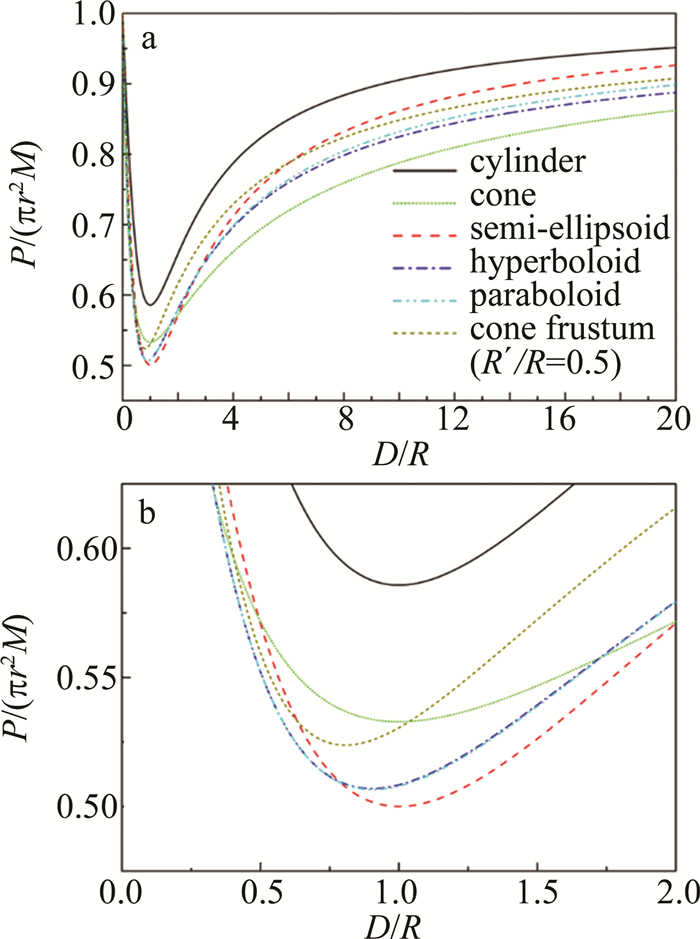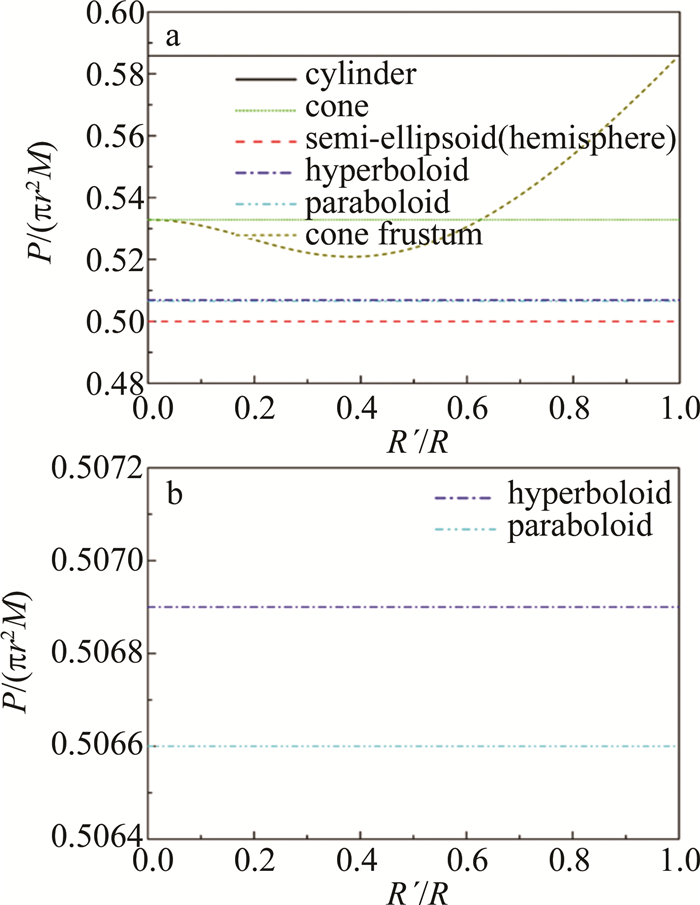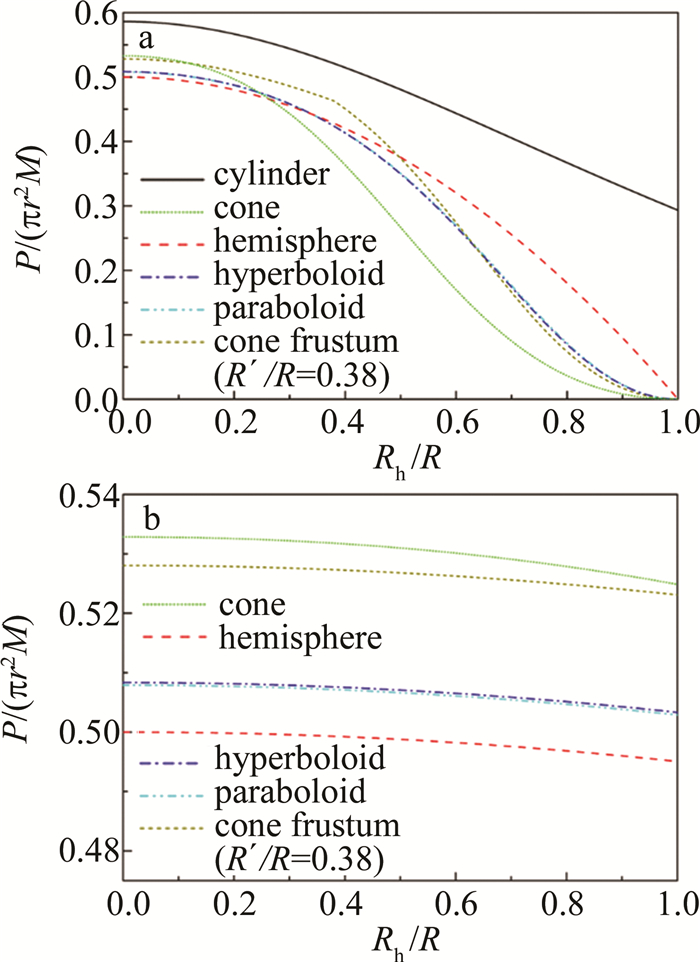Influence of spontaneous radiation on detectors of different-shape radiation shields
-
摘要: 为了研究不同形状的防辐射屏自发辐射对探测器的影响并找出影响最小的防辐射屏形状, 采用理论计算对抛物面、双曲面、半椭球面(含半球面)、台柱面(含圆柱面和圆椎面)的防辐射屏内屏自发辐射至探测器的功率进行了系统分析。结果表明, 各种形状防辐射屏自发辐射至探测器的功率随防辐射屏高度与底面半径比值的增大而先减小再增大, 其中最大值为与探测器尺寸相关的常数, 最小值出现在防辐射屏高度与底面半径接近或相等时; 当防辐射屏为半椭球面且高度和底面半径相等(即半球面)时, 自发辐射至探测器的功率小于其它任何形状的防辐射屏, 且与防辐射屏尺寸及顶部开小孔与否无关。本研究能为防辐射屏结构设计提供有价值的参考。Abstract: In order to clarify the influence of the spontaneous radiation of different-shape shields on detectors and find out the shape that has the least impact, the spontaneous power to the detector from the inner shields with different shapes was systematically analyzed by theoretical calculation. The shapes of the shields include paraboloid, hyperboloid, semi-ellipsoid (including hemisphere), and frustum of cone (including cylinder and cone). The results showed that the spontaneous power to the detector of all shapes of shields first decreases and then increase with the increase of the ratio of the height of the shield to the radius of the bottom. The maximum radiation power is a constant related to the size of the detector, and the minima appear when the heights of the shields are close to or equal to the radiuses of the bottoms. When the shield is semi-ellipsoidal and the height is equal to the radius (i.e., hemisphere), the power of spontaneous radiation to the detector is less than that of any other shield, and it has nothing to do with the size of the shield or whether there are small holes on the top. This study can provide a valuable reference for the design of radiation shields.
-
Keywords:
- detector /
- radiation shield /
- spontaneous radiation /
- cold shield /
- superconductor
-
-
Table 1 Photon emission rate spontaneously radiated to the detector by di-fferent shapes of shields at different temperatures /Hz
shape of the shield temperature of the shield T/K 60 70 80 90 hemisphere 1.213×104 2.507×105 2.484×106 1.505×107 paraboloid 1.229×104 2.539×105 2.517×106 1.525×107 hyperboloid 1.230×104 2.541×105 2.518×106 1.526×107 cone frustum 1.263×104 2.611×105 2.588×106 1.568×107 cone 1.292×104 2.671×105 2.647×106 1.604×107 cylinder 1.421×104 2.937×105 2.910×106 1.763×107 -
[1] ZHANG L B, KANG L, CHEN J, et al. Development of superconductor single-photon detector[J]. Electronic and Electro-optical Systems, 2010(4): 1-5(in Chinese).
[2] YOU L X. Status and prospect of superconducting nanowire single photon detection[J]. Infrared and Laser Engineering, 2018, 47(12): 1202001(in Chinese). DOI: 10.3788/IRLA201847.1202001
[3] ALLMAN M S, VERMA V B, HORANSKY R, et al. Progress towards a near IR single-photon superconducting nanowire camera for free-space imaging of light[C]//CLEO: Applications and Technology. Piscataway, NJ, USA: IEEE, 2014: 1-2.
[4] YAMASHITA T, LIU D, MIKI S, et al. Fluorescence correlation spectroscopy with visible-wavelength superconducting nanowire single-photon detector[J]. Optics Express, 2014, 22(23): 28783-28789. DOI: 10.1364/OE.22.028783
[5] LI H, CHEN S, YOU L, et al. Superconducting nanowire single photon detector at 532nm and demonstration in satellite laser ranging[J]. Optics Express, 2016, 24(4): 3535-3542. DOI: 10.1364/OE.24.003535
[6] EISAMAN M D, FAN J, MIGDALL A, et al. Invited review article: Single-photon sources and detectors[J]. Review of Scientific Instruments, 2011, 82(7): 071101. DOI: 10.1063/1.3610677
[7] NIWA K, NUMATA T, HATTORI K, et al. Few-photon color imaging using energy-dispersive superconducting transition-edge sensor spectrometry[J]. Scientific Reports, 2017, 7: 45660. DOI: 10.1038/srep45660
[8] SUN W, XIA Ch X, LI J, et al. Research on the influence of cold shield on the cooling process of infrared detector assembly[J]. Laser & Infrared, 2017, 47(10): 1286-1289(in Chinese).
[9] LU J T, ZHANG X Y, LI Y H. Test and analysis of average BRDF in different blackening processes of cold shield[J]. Laser & Infrared, 2016, 46(2): 196-199(in Chinese).
[10] LIU D K. Eletrical characteristics and large active-area research of superconducting nanowire single-photon detector[D]. Shanghai: University of Chinese Academy of Sciences, 2014: 34-36(in Chin-ese).
[11] HU X L, XU L, ZOU K, et al. A superconductor nanowire single-photon detection system in the mid-infrared band: China, 201910888886.0[P]. 2020-01-17(in Chinese).
[12] XIE X M, XU Q, CHEN J, et al. Research progress on antimonide based type Ⅱ superlattice mid- and long-infrared detectors[J]. Laser Technology, 2020, 44(6): 688-694(in Chinese).
[13] SHI M L, LING L. Status and development trends of the HgCdTe large infrared focal array technology[J]. Journal of Ordnance Equipment Engineering, 2017, 37(11): 916-920(in Chinese).
[14] GOPAL V, DHAR V. Cold radiation shield design for a linear detector array[J]. Infrared Physics, 1986, 26(2): 83-87. DOI: 10.1016/0020-0891(86)90025-4
[15] YE H F, YANG H M, WANG T J, et al. Anti-radiation screen assembly for cryogenic refrigerator: China, 201020155002.5[P]. 2010-11-24(in Chinese).
[16] YIN Sh, ZHU Y F, HUANG Y B, et al. The stray radiation su-ppression of the baffles of infrared focal plane dewar[J]. Infrared Technology, 2015, 37(11): 916-920(in Chinese).
[17] CHANG K, CHEN Sh Zh, WANG H, et al. Anti-radiation structure for low-temperature container: China, 201410172026[P]. 2016-03-30(in Chinese).
[18] JIN N, YANG K Y, CAO L, et al. Optimization design for the shapes of cold shield in infrared systems[J]. Acta Optica Sinica, 2016, 36(1): 0111005(in Chinese). DOI: 10.3788/AOS201636.0111005
[19] WANG Zh L, LI P Y, ZHANG Y T, et al. Circulating cooling radiation shield: China, 201720307684.9[P]. 2017-10-20(in Chin-ese).
[20] GONG J. Design method of large dimension cold shield based on G-M cryocooler[J]. Journal of Aerospace Power, 2019, 34(2): 341-347(in Chinese).
[21] AI J, LI Z G, POPOV A K. Gas drift induced by laser-produced plasma radiation[J]. Laser Technology, 1992, 16(5): 257-261(in Chinese).
[22] RANGANATH G S. Black-body radiation[J]. Resonance, 2008, 13(2): 115-133. DOI: 10.1007/s12045-008-0028-7




 下载:
下载:


